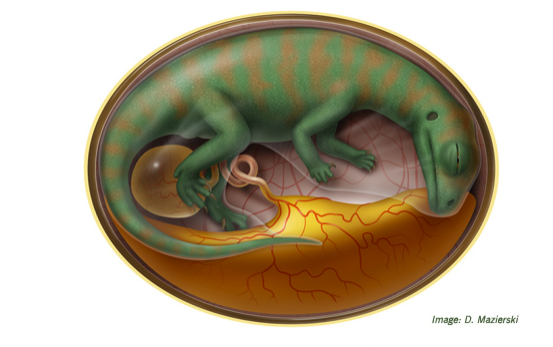Dinosaur Embryos Unearthed In China; Fossil Bones Also Contain Organic Material

Any baby's arrival is a joyous occasion for its parents, but when a trove of dinosaur embryos is unearthed in China, that's cause for celebration in the entire paleontological community.
Fossilized dinosaur embryos have been found before, but most specimens date to the Cretaceous period. The latest discovery, which includes eggshells and hundreds of tiny fossilized bones, is somewhere between 197 million and 190 million years old, hailing from the Early Jurassic period. It's the oldest cache of embryonic dinosaurs found yet. Scientists from China, Taiwan, Canada, Australia and Germany described the new find in a letter to the journal Nature, published online on Wednesday.
Even more surprising, there seems to be some organic material, in the form of the connective tissue collagen, clinging to the inside of the embryonic dinosaurs' bones.
“The bones of ancient animals are transformed to rock during the fossilization process,” lead author and University of Toronto Mississauga paleontologist Robert Reisz said in a statement. “To find remnants of proteins in the embryos is really remarkable, particularly since these specimens are more than 100 million years older than other fossils containing similar organic material.”
The embryos are similar to previously found specimens of Massospondylus, a mid-size dinosaur that looks a bit like a smaller Apatosaurus (which you might know as Brontosaurus) but which stands on two legs. However, the discoverers think the clutch more likely belongs to a member of another long-necked dinosaur genus called Lufengosaurus.
Discovering organic material in these fossils is especially surprising, given that the thigh bones of the embryos were porous, delicate things, according to Reisz.
“That suggests to us that other dinosaur fossils might have organic remains,” Reisz told Nature. “We just haven’t looked at them in the right ways.”
But don't start honing your dreams of cloning a dinosaur just yet. Finding trace amounts of organic material derived from dinosaurs is neat, but to resurrect a little Lufengosaurus, we'd need to also find traces of the animal's DNA -- and that's extremely unlikely.
“For years, researchers have known that DNA starts to break down almost immediately after an organism perishes,” science writer Brian Switek told Mental Floss. “Even in exceptionally preserved animals from more recent times -- such as frozen woolly mammoths found in Arctic permafrost -- the genetic material of the creatures has unraveled into fragments of what once was.”
North Carolina State University paleontologist Mary Schweitzer was the first scientist to find bits of soft tissue inside a dinosaur bone -- in her case, a Tyrannosaurus Rex. Some scientists are still skeptical that dinosaur flesh or even its derivations could really persist for millions of years. In 2008, a group of researchers argued in a PloS ONE paper that a more likely explanation for the material Schweitzer found was a bacterial biofilm that looks remarkably similar to collagen.
Even if the embryo fossils can't be used for cloning, they fill an important gap in our knowledge of dinosaur development. By studying the embryos, Reisz and other researchers may better understand how these dinosaurs grew up so quickly, eventually reaching a length of about 30 feet.
“The early life history of most dinosaurs is poorly documented, and the fossil record of dinosaur embryos is particularly scant in the Triassic and Jurassic periods,” David Evans, a curator at the Royal Ontario Museum’s Department of Natural History, told Discovery News. “The study by Reisz and colleagues is certainly the most detailed analysis of embryonic histology and development in an early dinosaur, and it will serve as a baseline for future comparisons with other species, which will deepen our understanding of dinosaur growth and evolution.”
SOURCE: Reisz et al. “Embryology of Early Jurassic dinosaur from China with evidence of preserved organic remains.” Nature 496: 210-214, 11 April 2013.
© Copyright IBTimes 2024. All rights reserved.





















